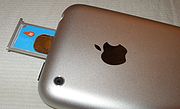
The iPhone is an Internet-enabled multimedia mobile phone designed and marketed by Apple Inc. It has a multi-touch screen with virtual keyboard and buttons, but a minimal amount of hardware input. The iPhone's functions include those of a camera phone and portable media player (equivalent to the iPod) in addition to text messaging and visual voicemail. It also offers Internet services including e-mail, web browsing, and local Wi-Fi connectivity. The first generation phone hardware was quad-band GSM with EDGE; the second generation also adds UMTS and HSDPA.[30]
Apple announced the iPhone on 9 January 2007.[31] The announcement was preceded by rumors and speculations that circulated for several months.[32] The iPhone was initially introduced in the United States on 29 June 2007 and is in the process of being introduced worldwide. It was named Time magazine's Invention of the Year in 2007.[33] On 11 July 2008, the iPhone 3G was released and supported faster 3G data speeds and Assisted GPS.[30]
Screen and interface
Almost all input is given through the touch screen, which understands complex gestures using multi-touch. The iPhone user interface enables the user to move the content itself up or down by a touch-drag motion of the finger. For example, zooming in and out of web pages and photos is done by placing two fingers on the screen and spreading them farther apart or closer together. Similarly, scrolling through a long list in a menu works as if the list is pasted on the outer surface of a wheel: the wheel can be "spun" by sliding a finger over the display from bottom to top (or vice versa). In either case, the list continues to move based on the flicking motion of the finger, slowly decelerating as if affected by friction. In this way, the interface simulates the physics of a real 3D object. There are other visual effects, such as horizontally sliding sub-selections and co-selections from right and left, vertically sliding system menus from the bottom (e.g. favorites, keyboard), and menus and widgets that turn around to allow settings to be configured on their back sidesAudio
The iPhone's headphones are similar to those of most current smartphones, incorporating a microphone. A multipurpose button in the microphone can be used to play or pause music, skip tracks, and answer or end phone calls without touching the iPhone. The 3.5 mm TRS connector for the headphones is located on the top left corner. The headphone socket on the original iPhone is recessed into the casing and is narrow when compared to some headphone jacks, making it incompatible with most headphones without the use of an adapter.[40] The iPhone 3G has a flush mounted headphone socket.
Wireless earpieces that use Bluetooth technology to communicate with the iPhone are sold separately. It does not support stereo audio.
The loudspeaker is used both for handsfree operations and media playback, but does not support voice recording.
Composite or component video at up to 576i and stereo audio can be output from the dock connector using an adapter sold by Apple.[41]
SIM card

The SIM card is located in a slot at the top of the device, which can be ejected with a paperclip or a SIM card ejection tool which is included with the iPhone 3G.[51] In most countries, the iPhone is usually sold with a SIM lock preventing the use of SIM cards from different mobile networks.
Storage
The iPhone was initially released with two options for internal storage size; either a 4 GB or 8 GB flash drive (manufactured by Samsung) model was available. On September 5, 2007, Apple announced they were discontinuing the 4 GB models.[52] On February 5, 2008, Apple announced the addition of a 16 GB model to the iPhone lineup.[53] The iPhone does not contain any memory card slots for expanded storageSpecifications
 nano, a first generation iPhone, and a fourth generation iPod, from top to bottom.
nano, a first generation iPhone, and a fourth generation iPod, from top to bottom.Features common to both versions
- Screen size: 3.5 in (89 mm)
- Screen resolution: 480×320 pixels at 163 ppi, with 3:2 aspect ratio
- Input devices: Multi-touch screen interface plus a "Home" button
- Built-in rechargeable, non-removable battery
- 2 megapixel camera
- Location finding by detection of cell towers and Wi-Fi networks
- Samsung S5L8900 (412 MHz[98] ARM 1176 processor, PowerVR MBX 3D graphics co-processor)[99]
- Memory: 128 MB DRAM[100]
- Storage: 8 GB or 16 GB flash memory
- Operating System: iPhone OS
- Quad band GSM / GPRS / EDGE: GSM 850 / 900 / 1800 / 1900
- Wi-Fi (802.11b/g)
- Bluetooth 2.0 with EDR
Original model
- 4 GB model (discontinued after two months)
- Size: 4.5 inches (115 mm) (h) × 2.4 inches (61 mm) (w) × 0.46 inch (11.6 mm) (d)
- Weight: 135 g (4.8 oz)
- Battery has up to 8 hours of talk, 6 hours of Internet use, 7 hours of video playback, and up to 24 hours of audio playback, lasting over 250 hours on standby.[34]
- Headphone jack (recessed)
- Digital SAR of 0.974 W/kg[101][102]
3G model
- Color: Black (8 GB or 16 GB) or white (16 GB)
- Size: 4.5 inches (115.5 mm) (h) × 2.4 inches (62.1 mm) (w) × 0.48 inch (12.3 mm) (d)
- Weight: 133 g (4.7 oz)
- Headphone jack (non-recessed)
- Battery has up to 10 hours of 2G talk, 5 hours of 3G talk, 5 (3G) or 6 (Wi-Fi) hours of Internet use, 7 hours of video playback, and up to 24 hours of audio playback, lasting over 300 hours on standby.[28]
- Tri band UMTS / HSDPA: UMTS 850 / 1900 / 2100
- Assisted GPS, with preference to location based on Wi-Fi or cell towers
No comments:
Post a Comment